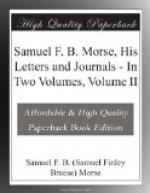“2. A knowledge that such a magnet had been made to lift and drop masses of iron of considerable weight.
“3. A knowledge, or a belief, that the galvanic current could be transmitted through wires of great length.
“These were all. Now comes the conception of devices for employing an agent which could produce reciprocal motion to effect registration, and the invention of an alphabet. In order to this invention it must be seen how up and down—reciprocal—motion could be produced by the opening and closing of the circuit. Into this simple band of vertical tracery of paths in space must be thrown the shuttle of time and a ribbon of paper. It must be seen how a lever-pen, alternately dropping upon and rising at defined intervals from a fillet of paper moved by independent clock-work, would produce the fabric of the alphabet and writing and printing.
“Was there anything required to produce these results which was not known to Morse?...
“He knew, for he had witnessed it years before, that, by means of a battery and an electro-magnet, reciprocal motion could be produced. He knew that the force which produced it could be transmitted along a wire. He believed that the battery current could be made, through an electro-magnet, to produce physical results at a distance. He saw in his mind’s eye the existence of an agent and a medium by which reciprocal motion could be not only produced but controlled at a distance. The question that addressed itself to him at the outset was, naturally, this: ’How can I make use of the simple up-and-down motion of opening and closing a circuit to write an intelligible message at one end of a wire, and at the same time print it at the other?’... Like many a kindred work of genius it was in nothing more wonderful than in its simplicity.... Not one of the brilliant scientific men who have attached their names to the history of electro-magnetism had brought the means to produce the practical registering telegraph. Some of them had ascended the tower that looked out on the field of conquest. Some of them brought keener vision than others. Some of them stood higher than others. But the genius of invention had not recognized them. There was needed an inventor. Now what sort of a want is this?
“There was required a rare combination of qualities and conditions. There must be ingenuity in the adaptation of available means to desired ends; there must be the genius to see through non-essentials to the fundamental principle on which success depends; there must be a kind of skill in manipulation; great patience and pertinacity; a certain measure of culture, and the inventor of a recording telegraph must be capable of being inspired by the grandeur of the thought of writing, figuratively speaking, with a pen a thousand miles long—with the thought of a postal system without the element of time. Moreover the person who is to be the inventor must be free from the exactions of well-compensated, everyday, absorbing duties—perhaps he must have had the final baptism of poverty.




